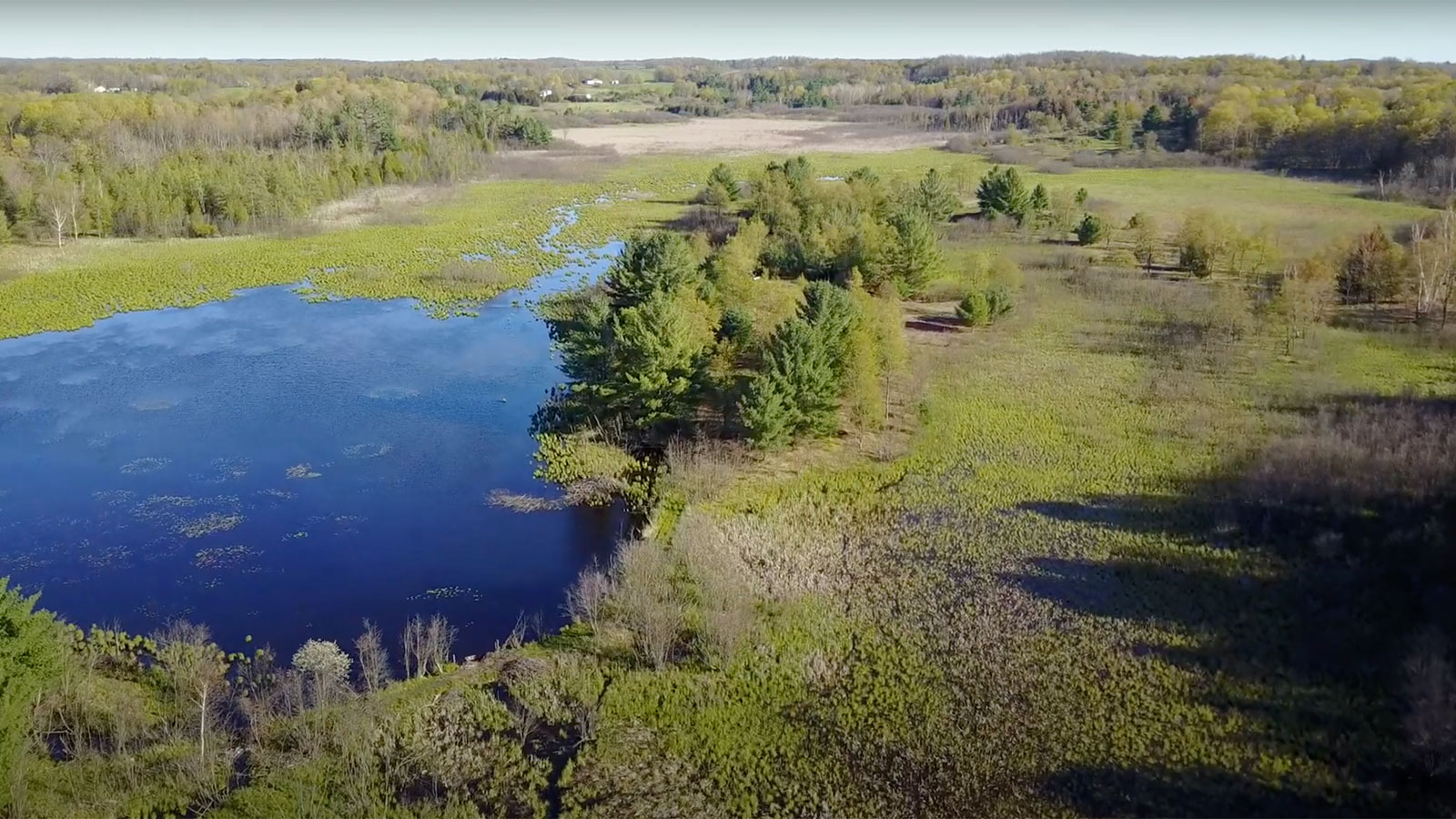A mile and a half below Doug Miller’s backyard in central Michigan lie the remnants of an ancient salty sea. When the waters receded around 350 million years ago, they left behind thick deposits of potash, a commonly used fertilizer. For Miller, a retired engineer, the stuff is out of sight, but top of mind, as the company Michigan Potash & Salt has sought to build a mining facility next door.
The facility would pull vast amounts of groundwater from the same aquifer as Miller’s. “I highly expect if they actually do this, my well would run dry,” he said.
The mine in the rural township of Evart has been in the works since 2012, and Russia’s invasion of Ukraine has raised the stakes. With its close ally Belarus, the two countries produce 40 percent of the world’s potash, which is rich in potassium, one of three essential plant nutrients. Prices were already on the rise, and shutting off major providers from global markets is expected to keep pushing them up. So the U.S., which imports nearly all of its potash, is looking to support domestic sources, like the planned mine next to Miller’s property.
For the Denver-based Michigan Potash & Salt, with 15,000 acres of mineral rights across Osceola and Mecosta counties, the Russian conflict is the latest reason why it needs to get its operations up and running ASAP. “Michigan Potash stands ready to support American farmers by replacing one-to-one all the potash imported from Russia,” said Theodore Pagano, the company’s founder and CEO, in a statement. In March, the U.S. Department of Agriculture announced a $250 million investment to support all-American fertilizer companies like Pagano’s. Once it’s operating, Michigan Potash’s site is expected to be the largest source in the country by far.
To Miller and others in the area, the risks of mining and pumping out all that groundwater to extract the potash simply aren’t worth it. They worry about the potential damage to sensitive wetlands as well as their drinking water. They question whether the U.S. really needs potash from central Michigan when there’s plenty at well-established facilities just across the U.S.-Canada border.
“All of a sudden you get a war overseas, and he’s fanning the flames that we have to have domestic production,” said Ken Ford, a forester in Osceola County, referring to Pagano.
While the U.S. relies heavily on international potash — importing 94 percent of its annual use — 83 percent of it comes from Canada, home to the largest mines in the world and directly connected by rail to the Corn Belt. (In March, a union strike shut down the railway for two days, stoking concerns about the tenuous supply chain.) Russia and Belarus each represent 6 percent.
In December, Michigan Potash obtained the last of the permits it needs to begin construction. The company would use solution mining to free the potash from the deep earth, valued at $65 billion. That involves injecting pressurized streams of hot saltwater, or brine, underground to dissolve the salt beds. Then, that brine would be pumped back to the surface, where it’s dried at high heat to extract the crystallized potash. Table salt is a byproduct of the process, which the company would sell, too.

This form of mining requires a lot of water: The Michigan Department of Environment, Great Lakes, and Energy, or EGLE, has already granted permission for Michigan Potash to extract 725 million gallons of groundwater each year. That amounts to some 2 million gallons a day — far exceeding the withdrawal allotted to the Nestlé bottled water plant just a few miles away.
Michigan Potash says it would recycle as much water as possible, calling its system a “closed loop.” Their production would capture the hot steam from boiling the potash out of the brine, which would supplement their water use. But only so much can be recycled. When the brine can’t be reused anymore, they’d inject the wastewater back underground into deep wells. Overall, the company has proposed boring 11 wells: eight for mining and three for waste.
Ford, who’s on the board for the Michigan Citizens for Water Conservation said the site is unsuitable for mining. It slopes on all sides. And it’s in the middle of four creeks that wander through a large freshwater marsh before flowing into the Muskegon River. “They literally could not have picked a worse location for this,” Ford said.
Members of the Michigan Citizens for Water Conservation fear the strain it would put on their watershed. They worry the sheer quantity of water used will dry up their wells and restrict water flows into the marsh. Sucking out vast quantities of water could force aquifers to migrate up, shuttling minerals and salts that would taint groundwater in a region where residents depend on private wells. “I don’t know what we’re supposed to do if the aquifer’s destroyed,” Miller said. “We’re out in the boondocks here. There’s no way we’re gonna get a municipal water source.”
A leak of the salty brine could also devastate their water supply, as well as the surrounding wetlands and waterways. Under high pressure, waste from injection wells can force its way out through cracks in the bedrock or old wells nearby, of which there are 36 around the proposed wells, according to an EPA survey. A ProPublica investigation found such leaks are fairly routine, growing more common as systems age.
In 2018, the Michigan Citizens for Water Conservation filed a complaint with the state environmental department, challenging Michigan Potash’s permits. A state judge rejected it last fall, clearing one of the company’s last hurdles. The group says the state hasn’t properly assessed the environmental impacts of the mining project. For instance, the state approved the company’s water permits through an online tool, without any formal review. That tool assesses how withdrawing water affects streamflow and fish population, but not the surrounding wetlands or underlying aquifers. Now, the environmental group is concerned Michigan Potash has no contingency plan for leaks or spills. (Calls and emails to the company and Pagano were not returned.)

Antoine Allanore, a metallurgy professor at the Massachusetts Institute of Technology, sympathized with the locals’ concerns. Mining ventures demand high initial investments, and the price to keep mines running safely is steep. To guarantee profits, “some shortcuts will have to be taken,” he said. “That’s my experience in every mining project. If the risk is high, even though the risk is unlikely, I don’t know if any community will accept it.”
Potash mining isn’t new in Michigan, nor even in Osceola County. A husk of a mine built in the 1980s sits just a few miles away from the Evart site. The mine exchanged hands over the years, passing through Mosaic — one of the world’s biggest fertilizer producers — before its current owner, the global agricultural conglomerate Cargill, took over. But today, the facility is only used to produce salt, not potash. Major companies have struggled to turn a profit from mining potash in the area, Ford said, explaining why he and his colleagues are skeptical of Pagano’s ability to do so. That skepticism grew when they learned about a past failed potash venture of Pagano’s in North Dakota.
According to Ford, who also sits on the Osceola County Planning Commission, the commission has invited Michigan Potash to discuss the project, but the company declined the meeting.
With the necessary permits for construction in hand, Michigan Potash says it’s securing the last funds before breaking ground on the site that borders Miller’s property. The company scored a $50 million boost from Michigan lawmakers in March when they approved a $4.8 billion spending plan, including the subsidy for potash-mining.
The land surrounding Miller’s home of 50 years is filled with forests, seeps, and springs. The marsh nearby is a pitstop for many migrating waterfowl like geese, cranes, and trumpeter swans, and the ducks have just arrived for spring. Miller worries that it could all be spoiled by one brine-filled pipeline springing a leak. “This thing is carrying tens of thousands of gallons per minute,” he said. “That kind of scenario would just be a disaster.”



